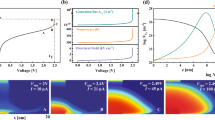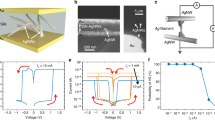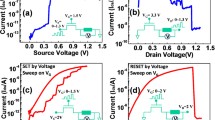Abstract
Solid electrolyte based-resistive memories have been considered to be a potential candidate for future information technology with applications in non-volatile memory, logic circuits and neuromorphic computing. A conductive filament model has been generally accepted to be the underlying mechanism for the resistive switching. However, the growth dynamics of such conductive filaments is still not fully understood. Here, we explore the controllability of filament growth by correlating observations of the filament growth with the electric field distribution and several other factors. The filament growth behavior has been recorded using in situ transmission electron microscopy. By studying the real-time recorded filament growth behavior and morphologies, we have been able to simulate the electric field distribution in accordance with our observations. Other factors have also been shown to affect the filament growth, such as Joule heating and electrolyte infrastructure. This work provides insight into the controllable growth of conductive filaments and will help guide research into further functionalities of nanoionic resistive memories.

Similar content being viewed by others
References
Waser, R.; Dittmann, R.; Staikov, G.; Szot, K. Redox-based resistive switching memories-Nanoionic mechanisms, prospects, and challenges. Adv. Mater. 2009, 21, 2632–2663.
Chen, A. Ionic memory technology. In Solid State Electrochemistry II: Electrodes, Interfaces and Ceramic Membranes. Kharton, V. V. Ed.; Wiley-VCH Verlag GmbH & Co. KGaA: Weinheim, Germany, 2011; pp. 1–30.
Lu, W.; Jeong, D.; Kozicki, M.; Waser, R. Electrochemical metallization cells-blending nanoionics into nanoelectronics? MRS Bull. 2012, 37, 124–130.
Yang, J. J. S.; Strukov, D. B.; Stewart, D. R. Memristive devices for computing. Nat. Nanotechnol. 2013, 8, 13–24.
Fujisaki, Y. Review of emerging new solid-state non-volatile memories. Jpn. J. Appl. Phys. 2013, 52, 040001.
Strukov, D. B.; Kohlstedt, H. Resistive switching phenomena in thin films: Materials, devices, and applications. MRS Bull. 2012, 37, 108–114.
Yu, S.; Lee, B.; Wong, H. S. P. Metal oxide resistive switching memory. In Functional Metal Oxide Nanostructures. Wu, J.; Cao, J.; Han, W.; Janotti, A.; Kim, H., Eds.; Springer: New York, 2012; pp. 303–335.
Tanachutiwat, S.; Liu, M.; Wang, W. FPGA based on integration of CMOS and RRAM. IEEE Trans. Very Large Scale Integr. VLSI Syst. 2011, 19, 2023–2032.
Liauw, Y.; Zhang, Z.; Kim, W.; Gamal, A. E.; Wong, S. S. Nonvolatile 3D-FPGA with monolithically stacked RRAM-based configuration memory. In Solid-State Circuits Conference Digest of Technical Papers (ISSCC), IEEE International, San Francisco, CA, USA, 2012, pp. 406–408.
Chang, T.; Yang, Y.; Lu, W. Building neuromorphic circuits with memristive devices. IEEE Circuits Syst. Mag. 2013, 13, 56–73.
Seok Jeong, D.; Kim, I.; Ziegler, M.; Kohlstedt, H. Towards artificial neurons and synapses: A materials point of view. RSC Adv. 2013, 3, 3169–3183.
Waser, R.; Aono, M. Nanoionics-based resistive switching memories. Nat. Mater. 2007, 6, 833–840.
Sakamoto, T.; Lister, K.; Banno, N.; Hasegawa, T.; Terabe, K.; Aono, M. Electronic transport in Ta2O5 resistive switch. Appl. Phys. Lett. 2007, 91, 092110.
Ohno, T.; Hasegawa, T.; Tsuruoka, T.; Terabe, K.; Gimzewski, J. K.; Aono, M. Short-term plasticity and long-term potentiation mimicked in single inorganic synapses. Nat. Mater. 2011, 10, 591–595.
Sakamoto, T.; Tada, M.; Okamoto, K.; Hada, H. Electronic conduction mechanism in atom switch using polymer solid electrolyte. IEEE T. Electron Dev. 2012, 59, 3574–3577.
Pan, F.; Yin, S.; Subramanian, V. A detailed study of the forming stage of an electrochemical resistive switching memory by KMC simulation. IEEE Electron Dev. Lett. 2011, 32, 949–951.
Yu, S. M.; Wong, H. S. P. Compact modeling of conducting-bridge random-access memory (CBRAM). IEEE T. Electron Dev. 2011, 58, 1352–1360.
Yang, Y.; Gao, P.; Gaba, S.; Chang, T.; Pan, X.; Lu, W. Observation of conducting filament growth in nanoscale resistive memories. Nat. Commun. 2012, 3, 732.
Xu, Z.; Bando, Y.; Wang, W.; Bai, X.; Golberg, D. Real-time in situ HRTEM-resolved resistance switching of Ag2S nanoscale ionic conductor. ACS Nano 2010, 4, 2515–2522.
Joshi, U. S. Ion irradiation: A tool to understand oxide RRAM mechanism. Radiat. Eff. Defects S. 2011, 166, 724–733.
Liu, Q.; Long, S.; Lv, H.; Wang, W.; Niu, J.; Huo, Z.; Chen, J.; Liu, M. Controllable growth of nanoscale conductive filaments in solid-electrolyte-based ReRAM by using a metal nanocrystal covered bottom electrode. ACS Nano 2010, 4, 6162–6168.
Sun, Q.; Gu, J.; Chen, L.; Peng, Z.; Wang P.; Ding, S.; Zhang, D. W. Controllable filament with electric field engineering for resistive switching uniformity. IEEE Electron Dev. Lett. 2011, 32, 1167–1169.
Bradley, J.; Chen, H.; Crawford, J.; Eckert, J.; Ernazarova, K.; Kurzeja, T.; Lin, M.; McGee, M.; Nadler, W.; Stephens, S. G. Creating electrical contacts between metal particles using directed electrochemical growth. Nature 1997, 389, 268–271.
Hsu, K.; Ferreira, P.; Fang, N. Controlled directional growth of silver microwires on a solid electrolyte surface. Appl. Phys. Lett. 2010, 96, 024101.
Balberg, I.; Azulay, D.; Toker, D.; Millo, O. Percolation and tunneling in composite materials. Int. J. Mod. Phys. B 2004, 18, 2091–2121.
Chen, L.; Li, Q.; Guo, H.; Gao, L.; Xia, Y.; Yin, J.; Liu, Z. Monte Carlo simulation of the percolation in Ag30Ge17Se53 amorphous electrolyte films. Appl. Phys. Lett. 2009, 95, 242106.
Valov, I.; Linn, E.; Tappertzhofen, S.; Schmelzer, S.; van den Hurk, J.; Lentz, F.; Waser, R. Nanobatteries in redox-based resistive switches require extension of memristor theory. Nat. Commun. 2013, 4, 1771.
Bang, S.; Chung, T.; Kim, Y. Plasma enhanced chemical vapor deposition of silicon oxide films using TMOS/O2 gas and plasma diagnostics. Thin Solid Films 2003, 444, 125–131.
Author information
Authors and Affiliations
Corresponding authors
Electronic supplementary material
Rights and permissions
About this article
Cite this article
Tian, X., Wang, L., Wei, J. et al. Filament growth dynamics in solid electrolyte-based resistive memories revealed by in situ TEM. Nano Res. 7, 1065–1072 (2014). https://doi.org/10.1007/s12274-014-0469-0
Received:
Revised:
Accepted:
Published:
Issue Date:
DOI: https://doi.org/10.1007/s12274-014-0469-0




